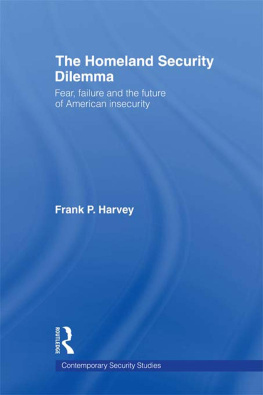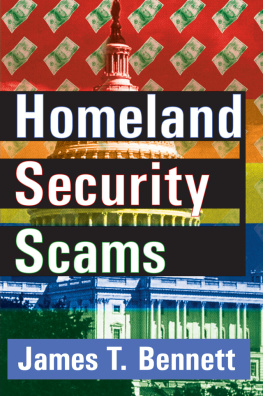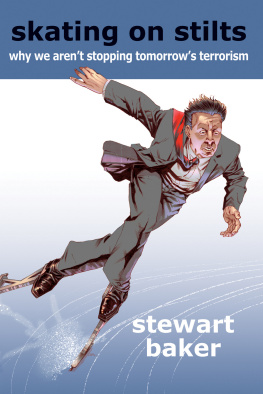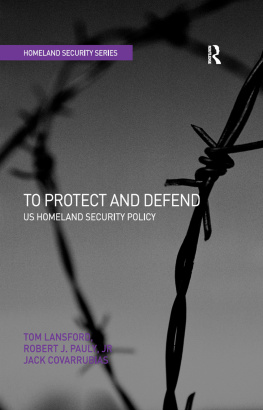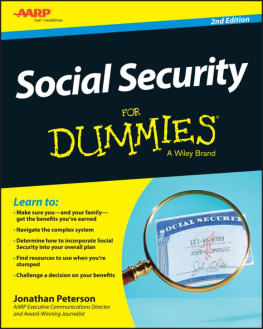Terror, Security, and Money
T ERROR, S ECURITY,
AND M ONEY
Balancing the Risks, Benefits, and Costs
of Homeland Security
John Mueller and Mark G. Stewart


Oxford University Press, Inc., publishes works that further
Oxford Universitys objective of excellence
in research, scholarship, and education.
Oxford New York
Auckland Cape Town Dar es Salaam Hong Kong Karachi
Kuala Lumpur Madrid Melbourne Mexico City Nairobi
New Delhi Shanghai Taipei Toronto
With offices in
Argentina Austria Brazil Chile Czech Republic France Greece
Guatemala Hungary Italy Japan Poland Portugal Singapore
South Korea Switzerland Thailand Turkey Ukraine Vietnam
Copyright 2011 by Oxford University Press
Published by Oxford University Press, Inc.
198 Madison Avenue, New York, New York 10016
www.oup.com
Oxford is a registered trademark of Oxford University Press
All rights reserved. No part of this publication may be reproduced,
stored in a retrieval system, or transmitted, in any form or by any means,
electronic, mechanical, photocopying, recording, or otherwise,
without the prior permission of Oxford University Press.
Library of Congress Cataloging-in-Publication Data
Mueller, John E.
Terror, security, and money : balancing the risks, benefits, and costs of homeland security /
John Mueller and Mark G. Stewart.
p. cm.
ISBN 978-0-19-979575-8 (hardcover) ISBN 978-0-19-979576-5 (pbk.)
1. TerrorismUnited StatesPreventionCost effectiveness.
2. TerrorismCosts. 3. National securityUnited StatesCosts.
I. Stewart, Mark G., 1961 - II. Title.
HV6432.M843 2011
363.325170973dc22 2011011771
9 8 7 6 5 4 3 2 1
Printed in the United States of America
on acid-free paper
To Judy and Xiaoli
CONTENTS
ACKNOWLEDGMENTS
We would like to thank the Mershon Center at Ohio State University and the Centre for Infrastructure Performance and Reliability at the University of Newcastle, Australia for travel and research support. Mark Stewart also appreciates the financial support provided by the Australian Research Council including a recent five-year ARC Professorial Fellowship which will allow this work to be continued. John Mueller appreciates the financial support from an Ohio State University Distinguished Scholar Award. A special thanks to Dr. Rick Herrmann, Director of the Mershon Center, for supporting Professor Stewarts visiting fellowships to the Mershon Center. We are grateful for helpful comments from David McBride and Judy Mueller. Thanks, too, to Jenny Wolkowicki and Ashwin Bohra for excellent work in expediting the production process.
Terror, Security, and Money
INTRODUCTION
In seeking to evaluate the effectiveness of the massive increases in homeland security expenditures since the terrorist attacks on the United States of September 1, 2001, the common and urgent query has been are we safer? This, however, is the wrong question. Of course, we are saferthe posting of a single security guard at one buildings entrance enhances safety, however microscopically. The correct question is are the gains in security worth the funds expended? Or as this absolutely central question was posed shortly after 9/11 by risk analyst Howard Kunreuther, How much should we be willing to pay for a small reduction in probabilities that are already extremely low?
TALLYING THE COSTS$1 TRILLION AND COUNTING
We have, in fact, paidor been willing to paya lot. In the years immediately following the terrorist attacks of September 11, 2001, on Washington and New York, it was understandable that there was a tendency to fashion policy and expend funds in haste, confusion, and maybe even hysteria on homeland security. After all, intelligence was estimating at the time that there were as many as 5,000 al-Qaeda operatives at loose in the country and, as New York Mayor Rudy Giuliani reflected later, Anybody, any one of these security experts, including myself, would have told you on September 11, 2001, were looking at dozens and dozens and multiyears of attacks like this.
The intelligence claims and the anxieties of Giuliani and other security experts have clearly proved, putting it mildly, to be unjustified. In the frantic interim, however, the U.S. government massively increased its expenditures for dealing with terrorism. As we approach the tenth anniversary of 9/11, federal expenditures on domestic homeland security have increased by some $360 billion over those in place in 2001, as demonstratesand the vast majority of this increase, of course, has been driven by concerns over terrorism. Moreover, federal national intelligence expenditures aimed at defeating terrorists at home and abroad have gone up by $110 billion, while state, local, and private-sector expenditures have increased by $220 billion more.
Table I.1 TOTAL AND ENHANCED HOMELAND SECURITY EXPENDITURES BY
THE U.S. GOVERNMENT, 2002 TO 2011, IN MILLIONS OF DOLLARS
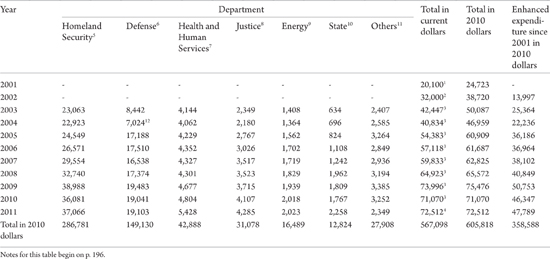
Tallying all these expenditures and adding in opportunity costsbut leaving out the costs of the terrorism-related (or terrorism-determined) wars in Iraq and Afghanistan and quite a few other items that might be includedthe increase in expenditures on domestic homeland security over the decade exceeds $1 trillion. The details are in
EVALUATING THE EXPENDITURES
This book seeks to apply conventional cost-benefit and risk analytic approaches to this huge increase in expenditures in an effort to provide an answer to Kunreuthers exceedingly apt question. These approaches have been recommended for many years by the U.S. Office of Management and Budget, and they are routinely used by such agencies as the Nuclear Regulatory Commission, the Environmental Protection Agency, and the Federal Aviation Administration. In 2004, the 9/11 Commission specifically called on the government to apply them to assess the risks and cost-effectiveness of security measures put in place to deal with terrorism. However, it appears that this simply has not been done.
Upon taking office in 2005, Department of Homeland Security (DHS) Secretary Michael Chertoff did strongly advocate a risk-based approach, insisting that the department must base its work on priorities driven by risk.
By 2007, RAND President James Thomson was contending that DHS leaders manage by inbox, with the dominant mode of DHS behavior being crisis management. Most programs are implemented, he continued, with little or no evaluation of their performance or effectiveness, and the And analyst Jeremy Shapiro argued:
Table I.2 THE TRILLION DOLLAR TABLE: ENHANCED COSTS OF HOMELAND SECURITY SINCE 9/11, IN BILLIONS OF 2010 DOLLARS

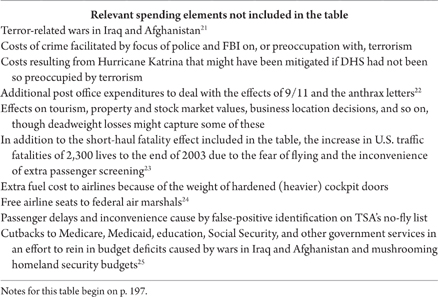
Policy discussions of homeland security issues are driven not by rigorous analysis but by fear, perceptions of past mistakes, pork-barrel politics, and insistence on an invulnerability that cannot possibly be achieved. Its time for a more analytic,
Next page

